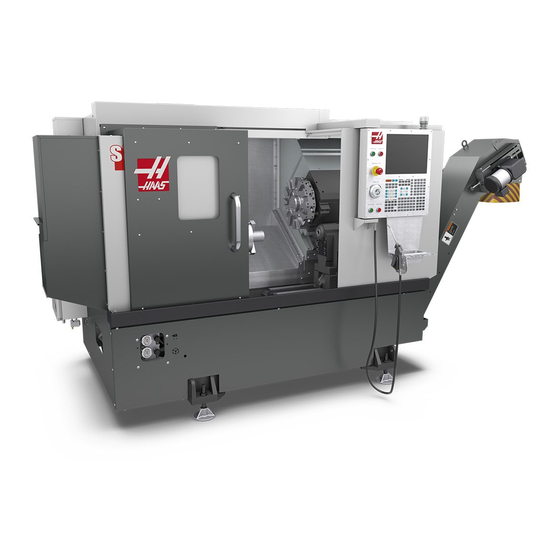
Advertisement
C-Axis - Engagement Offset - ST 15-30 - Lathe - NGC
NGC Lathe - C- Axis Engagement Offset
The NGC Lathe C-axis, no longer uses tool change offsets for orienting the C-axis relative to the Spindle. When the C-
axis is commanded to engage, it commands the C-axis to its Zero position and commands the Spindle to the Spindle
Orientation position (which is established during the alignment process)
C-Axis Disc Runout Check/Adjust
C-Axis - Engagement Offset - Lathe - NGC
Page 1 of 6 pages
1
Make sure the C-axis is disengaged (M155), and
the spindle can turn freely.
Loosen the bolts that hold the C-axis disc just
enough so that the runout of the disc and union
can be adjusted with a soft mallet. Verify that the
runout of the hydraulic union is less than 0.001"
TIR. If it is not, gently tap with the mallet until it is
within specification.
2
Once the runout of the union is within
specification, set the runout of the C-axis disc.
Place a small drill bit across the C-axis disc teeth
for the indicator to land on. This prevents the
indicator from interfering with the gear teeth.
Set the drill bit at four spots around the entire
diameter of the disc to measure the runout. If the
runout is greater than 0.001" TIR, tap the C-axis
disc with a soft mallet to bring it within
specification.
LAST UPDATED: 05/04/2020
Advertisement
Table of Contents

Summary of Contents for Haas ST Series
- Page 1 C-Axis - Engagement Offset - ST 15-30 - Lathe - NGC LAST UPDATED: 05/04/2020 C-Axis - Engagement Offset - Lathe - NGC NGC Lathe - C- Axis Engagement Offset The NGC Lathe C-axis, no longer uses tool change offsets for orienting the C-axis relative to the Spindle. When the C- axis is commanded to engage, it commands the C-axis to its Zero position and commands the Spindle to the Spindle Orientation position (which is established during the alignment process) C-Axis Disc Runout Check/Adjust...
- Page 2 C-Axis - Engagement Offset - ST 15-30 - Lathe - NGC Set C-axis Engagement Offset Page 2 of 6 pages...
- Page 3 C-Axis - Engagement Offset - ST 15-30 - Lathe - NGC Break the C-axis mount bolts loose but keep them slightly snug [1]. Move the mount away from the disc by turning the adjustment screw to the right (tightening on normal bolts) [2].
- Page 4 C-Axis - Engagement Offset - ST 15-30 - Lathe - NGC Press [RESET] but do not move the spindle or C- axis gears more than a tooth. Note: The [RESET] button is used instead of E- stop so that the C-axis stays oriented. Mesh the gears by turning the adjuster screw to the left until the C-axis drive gear is fully engaged with the disc gear.
- Page 5 C-Axis - Engagement Offset - ST 15-30 - Lathe - NGC Place a .0005" indicator against the motor mount and hand jog the C-axis to check the runout. Loosen the 4 bolts and adjust the cylinder block until the runout is between .0003-.0005". Torque the 4 cylinder block bolts and check (by jogging) to see that the axis runs smoothly and is still in the .0003-.0005"...
- Page 6 C-Axis - Engagement Offset - ST 15-30 - Lathe - NGC Go to the Settings tab • Set 216 Servo And Hydraulic Shutoff to 120 sec. Run the C-axis test program to verify the C-axis engagement is correct. Download the program HERE. Listen for smooth operation and no gear noises during engagement.





Need help?
Do you have a question about the ST Series and is the answer not in the manual?
Questions and answers
Добрый день.Нужно техническое описание по выставлению передне бабки и шпинделя для станка HAAS ST 10Y
The technical procedure for setting the front turret and spindle on the Haas ST-10Y involves careful installation and alignment steps. For the spindle, ensure all components are clean to prevent contamination. Use a hot plate for sweat fitting, a hoist for spindle cartridge installation, and alignment tools like a 2"x2" wood board. Balance the spindle using 3/8"-16 set screws, and verify spindle belt tension and vibration specifications using the Gates Sonic Tension Meter and Octavis Vibration Analyzer.
For proper adapter installation on the spindle, heat the adapter, run screws in a star pattern, torque them, let the adapter cool, then re-torque. Measure inner radial runout (≤0.001") and axial runout (≤0.0005"). If needed, adjust using a plastic mallet while indicating the adapter, and torque screws carefully to maintain runout specs.
Details specific to the front turret are not provided in the given context.
This answer is automatically generated